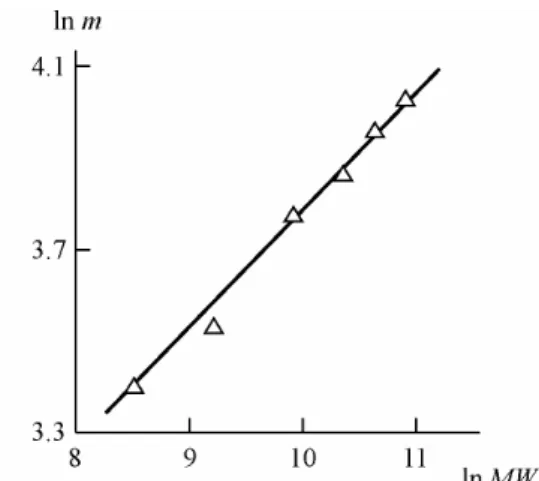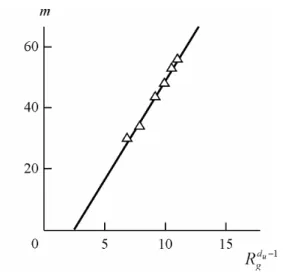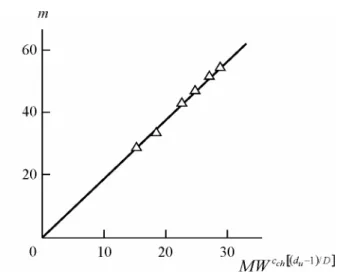Available on line at
Association of the Chemical Engineers AChE
www.ache.org.rs/CICEQ
Chemical Industry & Chemical Engineering Quarterly 14 (3) 181−184 (2008) CI&CEQ
181
G. V. KOZLOV1
A. I. BURYA2
G. B. SHUSTOV1
1 Kabardino-Balkarian State
University, Chernyshevsky st. 173, KBR, Nal’chik 360004, Russia
2State Agrarian University,
Voroshilov st. 25, Dnepropetrovsk 49027, Ukraine
SCIENTIFIC PAPER
UDC 547.426.2:544.1/2:532.74
THE DEPENDENCE OF THE CHAIN BRANCHING
DEGREE ON MOLECULAR WEIGHT:
FRACTAL ANALYSIS
The fractal analysis methodology allows the clear structural identification of both chemical and physical factors controlling a chain branching degree. The effective number of branching centers per one macromolecule m is controlled by four factors: polymer molecular weight, MW, maximal “chemical” density of reactive centers, cch, dimension of non-screening surface of macromolecular
coil, du, and its fractal dimension, D. The presented research allows the
deter-mination of the critical value, Dcr = 1.10, the lower of which branching degree is
equal to zero (i.e., branching does not occur).
Key words: polyhydroxyether; branching; structure; non-screening sur-face; critical dimension.
The branching degree of polymeric chain can be characterized by several parameters [1]. One of them is a number of branching centers per one ma-cromolecule m. The branching degree, g, determined from the scaling relationship [1,2], serves as another parameter:
g
MW
m~ (1)
where MW is the polymer molecular weight.
As a rule, the value g<1 [1] means that the number of branching centers is not proportional to the length of macromolecule or its polymerization degree, N. From the chemical point of view, such an effect is difficult to explain, as each monomer link in a macro-molecule has the same probability of branch forma-tion, and then one can expect m~N. However, in the
real conditions of polymer(s) synthesis there are a number of causes which can in principle cause the ratio m/N to decrease. One of such reasons can be the fact that the branching reactive centers, formed in initial stages of synthesis, are proved to be “buried” inside a macromolecular coil and, consequently, are less accessible [2]. This situation defines the neces-sity of the macromolecular coil structure allowance. As already known [3], a macromolecular coil in solu-tion is fractal and its structure (more exactly, distri-bution in space of its links) can be characterized by a
Corresponding author: Aleksandar Burya, State Agrarian Univer-sity, Voroshilov st. 25, Dnepropetrovsk 49027, Ukraine. E-mail: Ol.Burya@gmail.com
Paper received: Paper revised: Paper accepted:
fractal dimension, D. Therefore, the purpose of the present paper is description of macromolecular coil structure influence on the accessible for reaction number of branching centers at polymer molecular weight change. This description will be fulfilled within the framework of fractal analysis [4] on the example of polyhydroxyether synthesis [5].
EXPERIMENTAL
Polyhydroxyether (PHE) was synthesized by one- -step method, namely, by a direct interaction of epi-chlorohydrin and 4,4’-dioxidiphenylpropane (DPP) according to the scheme [5]:
G. V. KOZLOV, A. I. BURYA, G. B. SHUSTOV: THE DEPENDENCE OF CHAIN BRANCHING…. CI&CEQ 14 (1) 181−184 (2008)
182
The synthesis was made at three temperatures: 333, 338 and 343 K, since with such conditions branched polymers are obtained [6]. The dependen-ces of the produced viscosity, ηred, and the conversion
degree, Q, on the reaction duration, t, at mentioned T, as reported by Beeva and coworkes [5], were accep-ted. The macromolecular coil fractal dimensions, D, at these Ts are equal to 1.98, 1.89 and 1.69, respecti-vely [6].
The produced viscosity, ηred, was determined for
0.50 % PHE solution in chloroform on Ubbelode viscosimeter at 298 K.
RESULTS AND DISCUSSION
Besides the characteristics indicated above, only one more parameter, the branching factor, g’, can be used for estimation of polymer branching degree, which is determined as follows [7]:
2 θ ,l 2 θ '
R R
g = (2)
where R2θ and Rl,2θ are average gyration radia of the branched polymer and its linear analog in θ-solvent, respectively, at the same values of molecular weight, MW, and Kuhn segment size characterizing the chain thermodynamic rigidity [1].
In the ref. 6, the following fractal equation for g’ estimation was obtained:
θ θ l,
θ θ l, ) ( 2
' D D
D D
MW g
−
= (3)
where Dθ and Dl,θ are fractal dimensions of the
macro-molecular coil of a branched polymer and its linear analog in θ-solvent, respectively. The values Dθ and Dl,θ for PHE, synthesized at T = 333 K, are equal to
2.249 and 2.0, respectively [6].
Equation (3) supposes that g’ depends on the molecular weight. Parameters g’ and m are connec-ted according to the following relationship [1,7]:
5 . 0 5 . 0 ) 7 1 ( 9 4 '
−
⎥⎦ ⎤ ⎢⎣
⎡ + +
= m m
g
π (4)
The dependence mvs. MW for T = 333 K in log--log coordinates is shown in Fig. 1, which proves to be linear, and from its slope the value g ≈ 0.272 can be calculated. The dependences for the two remain-ing temperatures are similar and therefore they are not shown. The small g value supposes that macro-molecular coil structure strongly influences the m va-lue and this effect can be estimated quantitatively as follows. As it is known [8], one of the main features of
the fractal object structure is strong screening of its internal regions by the surface. Therefore, the reac-tion sites of the macromolecular coil accessible for branching are disposed either on its surface or near it. The number of such sites, Mu, is described according
to the following scaling relationship [8]:
u ~ u Rgd
M (5)
where Rg is coil gyration radius, du is a dimension of
non-screening surface of a macromolecular coil (ac-cessible for the reaction).
Fig. 1. The dependence of the number of branching center per one macromolecule, m, on the molecular weight, MW,
for PHE synthesized at 333 K.
The dimension du is determined according to the
following equation [8]:
w
u ( 1)
d D d D
d = − + − (6)
where d is dimension of Euclidean space in which fractal is immersed (it is obvious that in our case d = 3) and dw is the dimension of the random walk over fractal,
determined according to Aharony-Stauffer rule [9]:
1 w=D +
d (7)
Besides, it is well known [10] that in case of various chemical reaction proceedings, including syn-thesis of polymers, the so-called steric factor p (p≤1) plays an essential role, showing that not all collisions of reacting molecules occur with the proper orientta-tion of these molecules for the formaorientta-tion of chemical bonds. The value p is connected with Rg as follows [4]:
g
R
p~ 1 (8)
G. V. KOZLOV, A. I. BURYA, G. B. SHUSTOV: THE DEPENDENCE OF CHAIN BRANCHING…. CI&CEQ 14 (1) 181−184 (2008)
183 1
~
~ u
u
−
d g g d g
R R R
m (9)
In its turn, the value Rg can be estimated from
the known values MW. For PHE, the monomer link molecular weight, m0, determined from its chemical
constitution, is equal to 284. This makes it possible to determine the value of the monomer link(s) number per macromolecular coil, N:
0 m MW
N = (10)
Then, the value Rg can be calculated according
to the equation [11]:
D
g N
R
1 5 . 37
≈ (11)
The dependence of m vs. du−1
g
R according to the relationship (9) is shown in Fig. 2. As one can see, it is linear and has an expected feature: m increase with
1 u−
d g
R . The extrapolation of this plot to m = 0 gives 1
u−
d g
R ≈ 2.4, which corresponds to the smallest size of PHE macromolecule for beginning of the branching. This size is equal to ≈ 9.9 Å. It is possible to estimate PHE volume for monomer link, V0, according to the
equation [12]:
A
N m V
ρ 0
0= (12)
where ρ is the polymer density (for PHE, ρ≈ 1.15 g/cm2 [5]) and NA is Avogadro’s number.
Fig. 2. The dependence of branching center number per one macromolecule, m, on the composite parameter du−1
g
R , for PHE synthesized at 333 K.
Then, believing that the cross-sectional area of PHE macromolecule is equal to 30.7 Å2 [13] and using the volume V0≈ 410 Å3, calculated according to
the Eq. (12), the monomer link length for PHE, l0, can
be estimated to be equal to ≈ 13.4 Å. The comparison of the smallest value Rg and l0 indicates that PHE
chain branching process begins already at the initial synthesis stage.
We note that the dependences m vs. MW with fractional exponent q<1 are typical for other polymers as well. In ref. 7, the of Mark-Kuhn-Houwink constant for θ-solvent in the case of branched polyarylate (D–1) and its linear analogs have been reported, which allows calculation of intrinsic viscosities [η]θ and [η]l,θ,
for arbitrary MW. Then, the value of g’ can be esti-mated according to the relationship [7]:
a
g −
= 2 θ l,
θ ( ') ]
[ ] [ η
η
(13)
where a is an exponent in Mark-Kuhn-Houwink Equa-tion for a linear analog in θ-solvent (a = 0.5 [7]).
Knowing the values of g’, magnitudes of m can be calculated according to the Eq. (4). The estima-tions have shown, that for polyarylate (D-1) MW increases from 5×104 to 10×104 , while m increases from 2.0 up to 2.8, which corresponds to g ≈ 0.66.
Taking into consideration that gyration radius, Rg, scales to MW as follows [4]
D g MW
R
1
~ (14)
from relationship (9) one obtains:
D d
MW m
1 ~
u−
(15)
The comparison of the relationship (1) and (15) allows derivaton of the following equation:
D d c
g u 1
ch
−
= (16)
The proportionality coefficient, cch, in the Eq.
(16) has a clear physical significance: it defines the maximal density of “chemical” branching centers per one macromolecule. Parameter (du-1)/D defines the density decrease by macromolecular coil structural features for PHE value cch≈ 1.41. The values of g,
(du-1)/D and cch((du-1)/D) for PHE at three synthesis
temperatures, T, are listed in Table 1. Good corres-pondence of the first and the third parameters from the indicated ones is indicated.
For branched polyacrylate (D-1) the value of D can be determined according to the following equa-tion [14]:
a D
+ =
1 3
G. V. KOZLOV, A. I. BURYA, G. B. SHUSTOV: THE DEPENDENCE OF CHAIN BRANCHING…. CI&CEQ 14 (1) 181−184 (2008)
184
Table 1. Experimental and theoretical branching degree of PHE at different synthesis temperatures
T / K g
D du−1
D d c u 1
ch
−
333 0.272 0.193 0.270
338 0.229 0.145 0.203
343 0.130 0.105 0.147
Further, according to the Eqs. (6) and (7), by using a = 0.36 [7] and D ≈ 2.20, du can be determined
and cch can be calculated for (D-1) according to the
Eq. (16). In this case, cch ≈ 3.22, i.e., maximal
“chemical” branching center density for (D-1) is much higher than for PHE.
To conclude, the integral dependence of m on chemical and physical factors can be written as:
D d c
MW m
1 ~
u ch
−
(18)
The dependence corresponding to the relation-ship (18) is shown in Fig. 3. As one can see, this correlation is linear and passes through the origin. This is the case asserting that all factors controlling the value of m are taken into consideration.
Fig. 3. The dependence of the number of branching centers per
one macromolecule, m, on composite parameter D d c
MW
1
u ch
−
for PHE synthesized at 333 K.
CONCLUSIONS
The fractal analysis methods are efficient for clear structural identification of both chemical and physical factors, controlling a chain branching degree. The number of effective branching center(s) per one macromolecule, m, is controlled by four factors: poly-mer molecular weight, MW, maximal “chemical” den-sity of reactive centers, cch, dimension of
non-screen-ing surface, du, of macromolecular coil and its fractal
dimension, D. The Eq. (16) determines the critical va-lue D (Dcr), the lower of which g = 0 (i.e., branching
does not occur): Dcr=1.10.
REFERENCES
[1] V.P. Budtov, Physical Chemistry of Polymeric Solutions, Khimiya, Sankt-Peterburg, 1992, p. 384
[2] Z. Alexandrowicz, Fractals in Physics, L. Pietronero, E. Tosatti, (Eds.), North-Holland, Amsterdam, 1986, pp. 172 [3] V.G. Baranov, S.Ya. Frenkel, Yu.V. Brestkin, Doklady AN
SSSR 290 (1986) 369
[4] G.V. Kozlov, V.U. Novikov, Synergetics and Fractal Analysis of Cross-linked Polymers, Klassika, Moscow, 1998, p. 112
[5] D. A. Beeva, M. A. Mikitaev, G. E. Zaikov, A. A. Beev,
Molecular and High Molecular Chemistry: Theory and Practice, Yu. Monakov, G. Zaikov (Eds.), Nova Science Publishers Inc., New York, 2006, pp. 49-54
[6] G. V. Kozlov, G. E. Zaikov, J. Balkan Tribologic. Assoc. 9 (2003) 196
[7] A. A. Askadskii, Physics-Chemistry of Polyarylates, Khimiya, Moscow, 1968, p. 216
[8] P. Meakin, A. Coniglio, E. H. Stanley, T. A. Witten, Phys. Rev. A34 (1986) 3325
[9] M. Sahimi, M. McKarnin, T. Nordahl, M. Tirrell, Phys. Rev. A 32 (1985) 590
[10] F.S. Barns, Biofizika 41 (1996) 790
[11] F. S. Kozlov, I. V. Dolbin, G. E. Zaikov, Chemical and Biological Kinetics. New Horizons, Vol. 1, Chemical Kinetics, E. Burlakova, A. Shilov, S. Varfolomeev, G. Zaikov (Eds.), Brill Academic Publishers, Leiden-Boston, 2005, pp. 448-483
[12] G. V. Kozlov, D. S. Sanditov, Anharmonic Effects and Physics-Mechanical Properties of Polymers, Nauka, Novosibirsk, 1994, p. 261
[13] S. M. Aharoni, J. Appl. Polymer Sci. 16 (1972) 3275 [14] A. P. Karmanov, Yu. B. Monakov, Vysokomol. Soed. B 37


